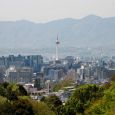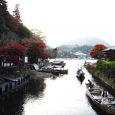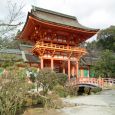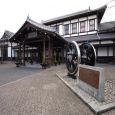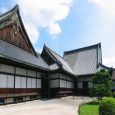Kyoto
Advertisement
By Air
Although Kyoto does not have its own airport, travelers can get to the city via Kansai International Airport and Itami Airport in Osaka Prefecture.The Haruka Express operated by JR West carries passengers from Kansai Airport to Kyoto Station in 73 minutes.Osaka Airport Transport buses connect Itami Airport and Kyoto Station Hachijo Exit in an hour and cost 1,280 yen for a one-way trip. Some buses go further, make stops at major hotels and intersections in downtown, and get to Nijo Station or the Westin Miyako Hotel Kyoto near Keage Station of Municipal Subway Tozai Line.
By Train
Kyoto Station is the center for transportation in the city.The second-largest in Japan, it houses a shopping mall, hotel, movie theater, Isetan department store, and several local government facilities all under one fifteen-story roof.The Tokaido Shinkansen Line as well as all conventional rail lines operated by JR West connect here.The Keihan, Hankyu, Kintetsu, and other rail networks also offer frequent service to other cities in the Kansai region. JR West and Kintetsu connect at Kyoto Station. Hankyu has a terminal at the intersection of Shijo Kawaramachi, Kyoto's most thriving shopping and amusement district.Keihan has a station at Sanjo Keihan which is not far from Shijo Kawaramachi.
By Bus
Kyoto's municipal bus network is extensive.Private carriers also operate within the city.Many tourists join commuters on the public buses, or take tour buses.Kyoto's buses have announcements in English and electronic signs with stops written in the Latin alphabet.Buses operating on routes within the city, the region, and the nation stop at Kyoto Station. In addition to Kyoto Station, bus transfer is available at the intersections of Shijo Kawaramachi and Sanjo Keihan.The intersection of Karasuma Kitaoji to the north of downtown has a major bus terminal serving passengers who take the Karasuma Line running beneath Karasuma Street, Kyoto's main north-south street.
By Road
The city is connected with other part of Japan by the Meishin Expressway, which has two interchanges in the city: Kyoto Higashi (Kyoto East) in Yamashina-ku and Kyoto Minami (Kyoto South) in Fushimi-ku.The Kyoto Jūkan Expressway connects the city to northern regions of Kyoto Prefecture.The Daini Keihan Road is a new bypass (completed in 2010) to Osaka.Unlike other metropolitan cities of Japan, Kyoto has poor network of intra-city expressways. As of 2010, only 8.2 km of the Hanshin Expressway Kyoto Route is in operation.There are nine national highways in the city of Kyoto: Route 1, Route 8, Route 9, Route 24, Route 162, Route 171, Route 367, Route 477 and Route 478.
Umekoji Steam Locomotive Museum
Is a railway museum located in Shimogyo-ku, Kyoto, Japan.Opened in 1972, the former locomotive depot preserves 19 steam locomotives.The museum is owned by West Japan Railway Company (JR West) and is operated by Transportation Culture Promotion Foundation.Exhibition of other historical materials is in a two-story wooden building adjacent to the roundhouse.This is the former station building of Nijo Station in Kyoto.The building was built in 1904 and was moved to the museum ground in 1997.The museum was opened by Japanese National Railways (JNR) on October 10, 1972 commemorating the centennial of the railway in Japan.When JNR was divided into regional companies in 1987, the museum was inherited by JR West.
Kyoto Botanical Garden
Is a major botanical garden with conservatory located next to the Kamo River, Hangi-cho Simogamo, Sakyo-ku, Kyoto, Japan.It is open daily an admission fee is charged.The garden also contains a very substantial conservatory complex (4,612 m2) containing about 25,000 specimens representing 4,500 species. It is a set of rooms shaped to resemble the nearby Kinkaku-ji Temple and Kyoto's northern mountains, built of glass with iron frames, and opened in 1992.It currently contains the following areas: Ananas Room; Aquatic and Carnivorous Plants; Bromeliads Room; Desert and Savanna Plants Room; Forest Succulent Plants Room; Jungle Zone; Orchids Room; Potted Plants Room; Tropical Alpine Plants Room; and Tropical Produce Room.
Kamigamo Shrine
Is an important Shinto sanctuary on the banks of the Kamo River in north Kyoto, first founded in 678.Its formal name is the Kamo-wakeikazuchi Shrine.It is one of the oldest Shinto shrines in Japan and is one of the seventeen Historic Monuments of Ancient Kyoto which have been designated by UNESCO as a World Heritage Site.The term Kamo-jinja in Japanese is a general reference to Shimogamo Shrine and Kamigamo Shrine, the traditionally linked Kamo shrines of Kyoto.The Kamo-jinja serve the function of protecting Kyoto from malign influences.
Nijo Castle
Is a flatland castle located in Kyoto, Japan.The castle consists of two concentric rings of fortifications, the Ninomaru Palace, the ruins of the Honmaru Palace, various support buildings and several gardens.The surface area of the castle is 275,000 square meters, of which 8000 square meters is occupied by buildings.The 3300 square meter Ninomaru Palace (Ninomaru Goten) consists of five connected separate buildings and is built almost entirely of Hinoki cypress.The decoration includes lavish quantities of gold leaf and elaborate wood carvings, intended to impress visitors with the power and wealth of the shoguns.The sliding doors and walls of each room are decorated with wall paintings by artists of the Kano school.
Kiyomizu-dera
Officially Otowa-san Kiyomizu-dera is an independent Buddhist temple in eastern Kyoto.The temple is part of the Historic Monuments of Ancient Kyoto (Kyoto, Uji and Otsu Cities) UNESCO World Heritage site.(It should not be confused with Kiyomizu-dera in Yasugi, Shimane, which is part of the 33-temple route of the Chugoku 33 Kannon Pilgrimage through western Japan.)Kiyomizu-dera was founded in the early Heian period.The temple dates back to 798, and its present buildings were constructed in 1633, during a restoration ordered by the Tokugawa Iemitsu.There is not a single nail used in the entire structure.It takes its name from the waterfall within the complex, which runs off the nearby hills.Kiyomizu means clear water, or pure water.
Imperial Palaces and Villas
Stroll through the regal retreats of the Imperial Palace or one of the two Imperial villas with gardens and teahouses managed by the Imperial Household Agency.These are the Imperial Palace (Kyoto-gosho) and Sento Imperial Palace (Sento-gosho) in Central Kyoto, Katsura Imperial Villa (Katsura-rikyu) in Western Kyoto, and Shugakuin Imperial Villa (Shugaku-in-rikyu) in Northern Kyoto.All four of these sites are open to the public by reservation through the Imperial Household Agency.The gardens located within the precints of each palace and villa are at their most scenic during spring cherry blossom season and autumn where a riot of colors enchant visitors.Each property is still used from time for official state functions or for private visits by the current royal family members.
June - August
December - February
April - June


